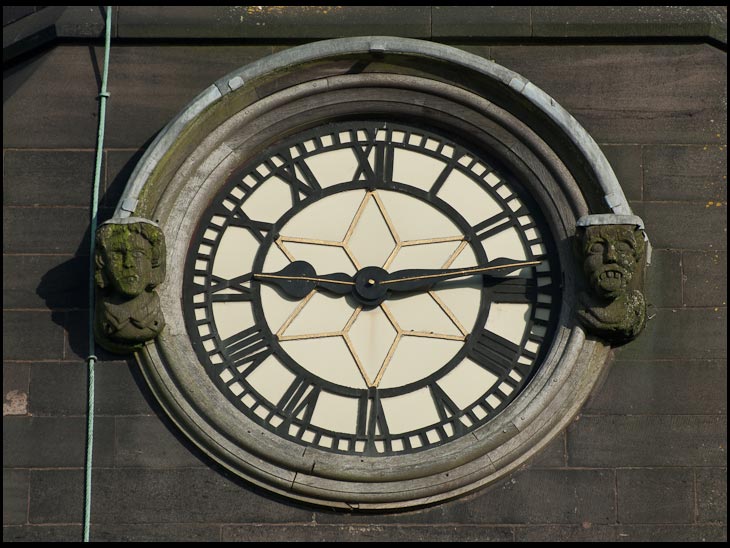Photo-a-Day (Monday, 5th November, 2012)
Amused about time

Photo: John Morris (Nikon D200 and a Nikon 70-300 VR lens)
Time marches on. Has there been some repair work done on the outer framework there seems to be an extra band on the top half. Muses or Gargoyles??
That,s a great shot of the clockface, i lived only 100 yards from the church for many years and looked at the clock what, 20 times a day? but i have never seen it as clear as that, thank you John
Great photo John. As Roy says, you see something on a regular basis but don't actually 'see' it. I set myself the task of walking around Atherton a few months back to see what opportunities presented themselves for photographs - and it turned out to be quite a few. An interesting exercise.
What a striking picture John, excuse the use of words!!! I remember this church just a little as my church was St Marie's so I never went in St Wilfs but I am sure I would have seen this magnificent clock face often. Cheers!!
Definately not Gargoyles Ken, as you probably know they are designed to take water through a spout from a roof or the side of a building. You tell what a 'muse' is, in Greek mythology it was one of nine goddesses,what is a modern day muse?
Thanks Roy, the repairwork probably is lead flashing around them top half and capping the "Muses"
As i said earlier i lived 100 yards from the church for 20 odd years, all the 40s,50s and early 60s, there are 3 clocks on the steeple and the strike is every 15 minutes for 365 days a year, that,s 35,040 strikes a year plus the hour strike which as you know is anything between 1 and 12 times. The number of times i,ve lain awake listening to the chimes i couldn,t say, but it was a lot. Lie in,s were very few and far between, it sounds like i,m complaining but i wouldn,t have wanted it any other way, it was all part of village life then and still is, albeit a bigger 'village' now.
I`m a bit surprised that nobody has said that there are only three clockfaces and not four.
They are on the North, South and West sides.
Refer:-
http://www.british-history.ac.uk/report.aspx?compid=53094
Is that the time already.
Thanks for the comments everyone. I took the name "muses" from the former Rector. In reply to Janice, it is indeed an interesting exercise,to really LOOK, and what you see can change dramatically depending on the position of the sun. The mundane can change into a thing of beauty as the light changes.
The general name for carved "ornamental" figures is "grotesques" and very often they are "ugly" reflecting the common usage of the word. However they can be "decorative." A "grotesque" that is a water-spout is a "gargoyle".
It is not too unusual for church clock towers to have only three faces with clocks. Much depends on the height of the clock/tower. If the clocks are positioned very high and well above the main roof of the church they be easily seen from all directions and there are likely to be four clocks. If this is not the case and the roof impedes the view of the clock tower, then there might be three. Since many clock towers are at the west end of the church (at the entrance) then the roof would obstruct the east face of the clock tower and this is the face most likely not to have a clock.
good shot john well done.
Ken R, the lead flashing and capping the "Muses" is likely to be, in addition to repair, preventative maintenance. Stonework corrosion can occur due to weak sulphuric acid rain which is caused by sulphur di-oxide formed by burning fossilized fuel. As you can see, it is the upper parts of the stonework that are being protected, precisely those areas where rain might lodge/penetrate.
Roy, your comment at 15:06 wasn`t shown when I posted my comment at 16:50.
Wow,didnt expect that !
Didn`t expect what? Jean
No problem Ernest!
A completely different picture to what we normally see Ernest,,,I think it is great!
Couldn't agree more, when the expected comes we come to expect. I agree with Mick and Neil.
I,m with Roy on this